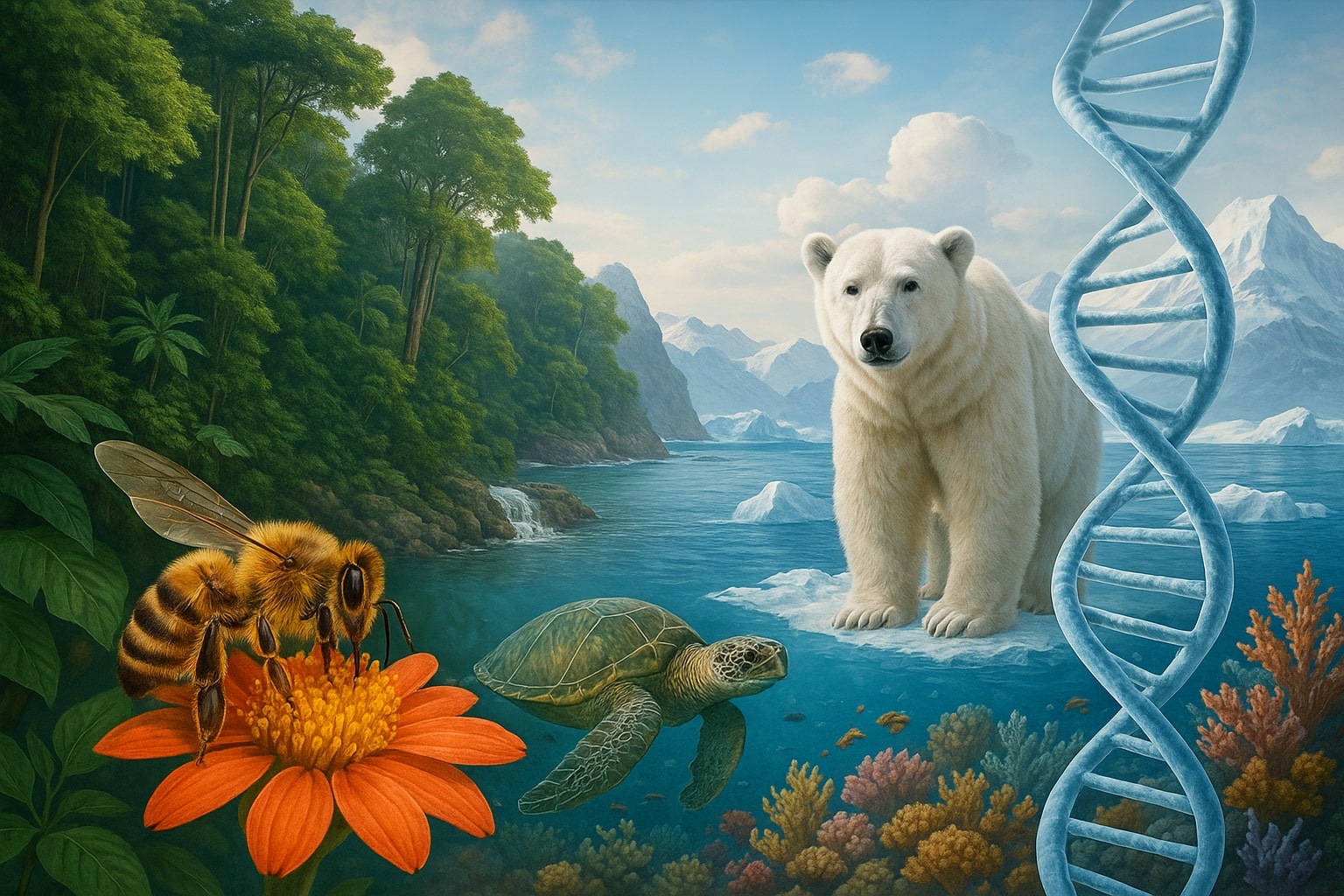Table of Contents
ToggleIntroduction: The Beauty of Biodiversity
Biodiversity is more than just a buzzword. It’s the very foundation of life on Earth—a rich, dynamic network of plants, animals, microorganisms, and ecosystems. Each thread in this vibrant tapestry plays a vital role in maintaining the balance of nature. From the deepest oceans to the tallest mountains, biodiversity fuels the processes that support life as we know it.
Yet, this intricate system is under threat. Human activity, climate change, and pollution are unraveling nature’s weave, posing one of the greatest challenges of our time.

What Is Biodiversity?
Biodiversity—short for biological diversity—refers to the variety and variability of all life forms on Earth. It includes:
Genetic Diversity: The variety of genes within a species (e.g., different breeds of dogs).
Species Diversity: The variety of species in a particular region (e.g., tigers, dolphins, orchids).
Ecosystem Diversity: The variety of ecosystems (e.g., rainforests, coral reefs, deserts).
Together, these elements form a web of life that sustains the natural world and supports human society.

Importance of Biodiversity
Biodiversity is not just about the beauty of nature—it’s essential for survival.
🌱 1. Ecosystem Services
Healthy ecosystems provide:
Clean air and water
Pollination of crops
Climate regulation
Soil fertility
Waste decomposition
These services, known as ecosystem services, are crucial for human survival and economic well-being.
🧪 2. Medicine and Research
Over 50% of modern medicines are derived from natural sources. Aspirin, antibiotics, and even cancer treatments trace their roots to biodiversity.
🧘 4. Cultural and Spiritual Significance
From sacred groves in India to tribal traditions in the Amazon, biodiversity shapes human cultures and identities.

Biodiversity Hotspots: Nature’s Treasure Chests
There are regions on Earth with extraordinary biodiversity, often called biodiversity hotspots. These include:
🌳 Amazon Rainforest (South America)
🐅 Western Ghats (India)
🌿 Congo Basin (Africa)
🐦 Sundaland (Indonesia and Malaysia)
🐢 Coral Triangle (Southeast Asia)
Despite covering only 2.3% of Earth’s surface, these areas harbor over 50% of the world’s plant species.
Major Threats to Biodiversity
Sadly, biodiversity is in crisis. The UN reports that over 1 million species are at risk of extinction. The key threats include:
🔥 1. Habitat Destruction
Deforestation, urban expansion, and mining destroy natural habitats, displacing species and disrupting ecosystems.
🛢 2. Pollution
Plastic waste, chemical runoff, and oil spills contaminate land and water, killing organisms and degrading ecosystems.
🌡 3. Climate Change
Rising temperatures, changing rainfall patterns, and extreme weather affect species’ habitats and migration.
🌾 4. Overexploitation
Overfishing, illegal hunting, and unsustainable agriculture deplete resources faster than nature can replenish them.
🌱 5. Invasive Species
Non-native species introduced to an area often outcompete or prey on native species, disrupting ecological balance.
Consequences of Biodiversity Loss
Losing biodiversity has cascading effects:
Weakened ecosystems can no longer provide essential services.
Increased vulnerability to diseases and natural disasters.
Loss of livelihoods for communities dependent on forests, oceans, and wildlife.
Cultural erosion, as species tied to traditions and beliefs disappear.
Conservation of Biodiversity: What’s Being Done?
🛡 1. Protected Areas
Creating national parks, wildlife sanctuaries, and marine reserves helps safeguard species and habitats.
📜 2. International Agreements
Convention on Biological Diversity (CBD)
CITES (Convention on International Trade in Endangered Species)
Paris Agreement (indirect impact through climate mitigation)
🌱 3. Sustainable Practices
Agroforestry
Organic farming
Sustainable fisheries
These practices balance human needs with ecological preservation.
🧬 4. Conservation Genetics
Breeding programs and seed banks preserve genetic diversity and help restore endangered species.
🧑🤝🧑 5. Community Involvement
Local communities, especially indigenous groups, are vital stewards of biodiversity. Empowering them ensures long-term conservation.
India and Biodiversity
India is one of the 17 megadiverse countries in the world, home to:
Over 45,000 plant species
Around 91,000 animal species
Four recognized biodiversity hotspots
Initiatives like Project Tiger, Eco-Sensitive Zones, and the National Biodiversity Action Plan are vital to India’s conservation efforts.
Biodiversity and the Economy
Biodiversity isn’t just about nature—it’s an economic asset.
Global GDP depends heavily on nature (over $44 trillion of economic value is moderately or highly dependent on nature, according to the WEF).
Sectors like agriculture, fisheries, forestry, and tourism are biodiversity-based.
Failure to protect biodiversity means economic instability.
How You Can Help: Everyday Actions
✅ 1. Support Eco-friendly Products
Choose certified sustainable, organic, or local products.
✅ 2. Reduce, Reuse, Recycle
Minimize plastic use and reduce waste.
✅ 3. Plant Native Trees
Help restore ecosystems by planting local flora.
✅ 4. Educate and Advocate
Raise awareness about biodiversity in your community and support policies that protect the environment.
✅ 5. Avoid Illegal Wildlife Products
Say no to exotic pets, ivory, coral jewelry, or any endangered species products.
Future Outlook: Can We Restore Nature?
With global awareness rising and nature-based solutions gaining traction, there is hope. Initiatives like the UN Decade on Ecosystem Restoration (2021–2030) are rallying nations to bring back what’s been lost.
Technology, science, and indigenous wisdom—combined with political will—can help reverse biodiversity loss. But time is of the essence.
What is biodiversity in simple terms?
Biodiversity means the variety of all living things—plants, animals, fungi, and microbes—on Earth. It includes their genes, species, and ecosystems.
Why is biodiversity important?
It provides essential services like clean air, food, water, and medicine. It also supports ecosystems that help regulate the climate and protect against disasters.
What is India doing to protect biodiversity?
India has several programs like Project Tiger, Biodiversity Act 2002, National Parks, and Wildlife Sanctuaries to protect and conserve its rich biological heritage.













